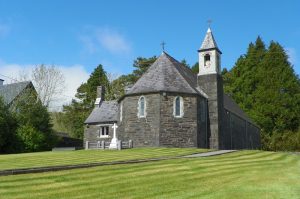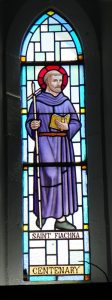St. Feaghna’s Church

St Feaghna’s Church stands proudly in the heart of Bonane village, slightly elevated above road level of the N71 which passes it by. Named after Bonane’s patron saint, this church was built on the grounds of an existing chapel which had fallen into disrepair.
In 1839, Bonane parish priest Fr Michael Enright appealed to the Marquis of Lansdown for funds for a new chapel to replace the current one which was ‘a mud cabin with a thatched roof’. The Marquis donated the site and money towards the project, and a chapel was raised on the spot of modern day’s St Feaghna’s. However, only fifty years later, parish priest Fr John Mangan saw the need for a new church, writing to his bishop that the church was in ‘bad repair’.

Following Fr Mangan’s fundraising efforts, the church standing in Bonane today was built in the same spot as its predecessor. Only a wall of the previous building can still be seen just west of the new church. Stones for constructing the church were taken from the lands of local farmers and brought to the site by horse and cart. Local lore has it that stone masons lined the road for a quarter of a mile, dressing the stones.
The new church was blessed on 18th May 1892 and The Catholic Directory reported: “The belfry, tower and altar (by Earley and Powell, Dublin), the confessional, the baptistery and the sacristry and its appointments, are simply perfect, and in keeping with the style and finish of the church. The whole was designed by Mr Daniel O’Connell, Derrynane House, [grandson of The Liberator] and built by Daniel Foley, Sneem. It certainly reflects great credit on the architect and builder. The entire cost is under £1,400 […]. The church is pointed and consists of a nave, 70 feet by 21, and a sanctuary, terminating in a pentagonal apse. The church is dedicated to St Feachna [sic], patron saint of the parish.”


In 1894, the Presbytery was built adjacent the new church. It is a very handsome building standing on 3.5 acres of gardens and woodland. After it had been bought by a family from Midleton, Co. Cork, it was used as a Bed & Breakfast for some time. An outbuilding behind the Presbytery served as a Youth Hostel for many years. Visitors to Bonane please note that the Presbytery is now a private residence, so please respect the new owners’ privacy.
St Feaghna’s Church has remained practically unchanged since 1892. In the 1960s, the sanctuary was moved according to the new liturgy following the Second Vatican Council. In celebration of St Feaghna’s Church’s centenary in 1992, each family in the parish contributed to the installation of beautiful stained glass windows in memory of their dear departed loved ones. The church was re-roofed in 2012.
Two graves lie in the lawns of the church. One belongs to Rev James Quill who served as parish priest from 1892 until his untimely death, at the age of forty, in 1898. The newer grave is that of Rev Eugene Daly, a parishioner who served as a priest in the UK and retired home to Bonane. He lived with his sister Mary until he passed away in January 2001. Fr Daly had a great love for the Mass Rock at Inse an tSagairt and its history. He was instrumental in negotiating with the forestry service to open it to the public.
In recent years, St Feaghna’s Church has become a very popular wedding tourism location due to its pretty setting and simple elegance. To discuss celebrating your wedding here, please contact Fr Niall Howard on 027 63045 or 086 2498967.
(Sources: Bonane – A Centenary Celebration, Edited by Fr John Shine; A Guide to the Sheen Valley Heritage Area, by Bonane Community Council)